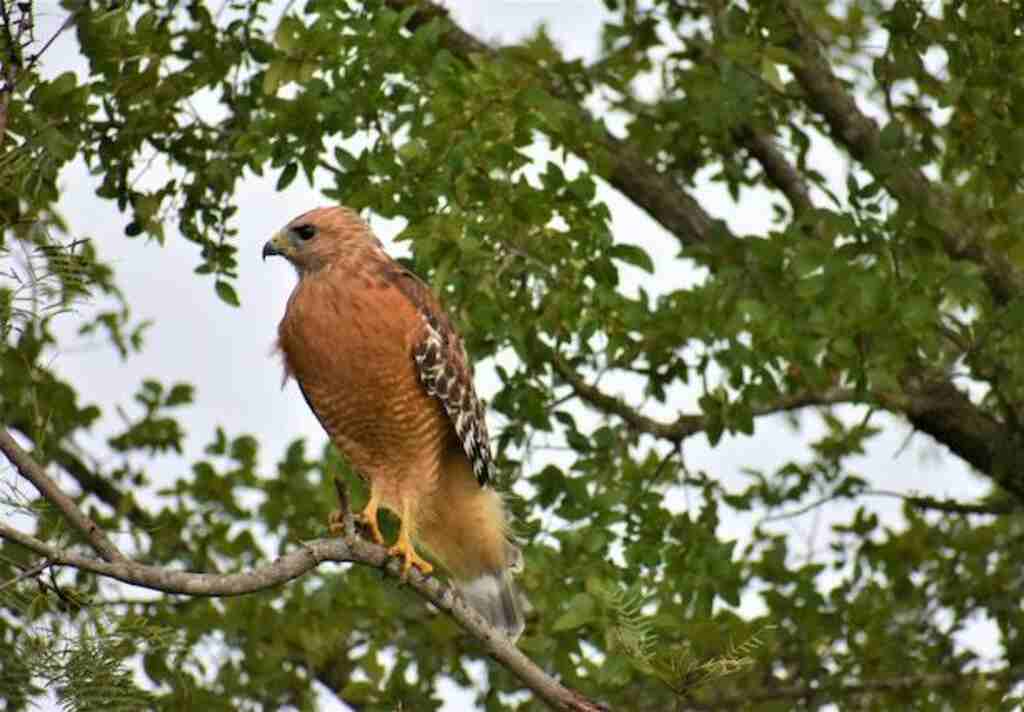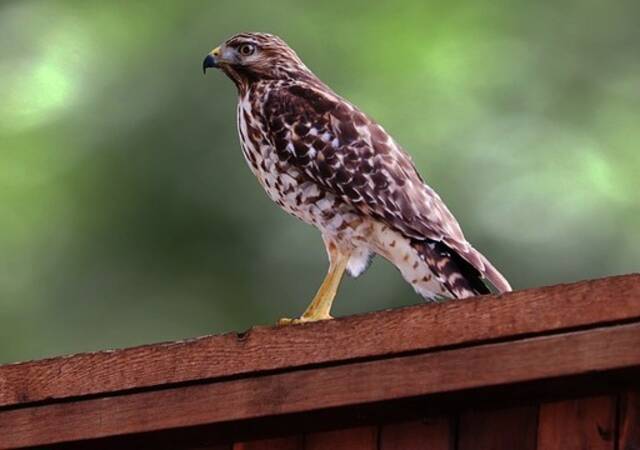You may have seen hawks soaring high in the sky, their sharp eyes scanning the ground for prey. These magnificent birds of prey are known for their powerful talons and keen senses, making them an important part of the ecosystem.
But are hawks endangered? In this captivating article, we embark on a journey to uncover the truth. Discover the population status of hawks and the daunting threats they face due to human impact.
Join us as we delve into the efforts being made to protect these majestic creatures and the crucial role they play in maintaining ecological balance.
By the end, you’ll not only learn about the fate of hawks, but also find inspiration to safeguard their freedom to soar through the skies. Get ready for a wild ride of knowledge and conservation!
Table of Contents
Are Hawks Endangered?
Hawks are a diverse group of birds, and the conservation status varies among different species. While some hawk species face threats and declining populations due to habitat loss, pollution, and human activities, not all hawks are endangered.
It is important to assess the status of specific hawk species to determine their conservation needs.
Conservation efforts and habitat preservation play a crucial role in protecting hawks and ensuring their continued presence in the wild.
Here’s a table showcasing some hawk species that are facing conservation challenges:
| Hawk Species | Conservation Status |
|---|---|
| Philippine Eagle | Endangered |
| Madagascar Fish Eagle | Critically Endangered |
| Hawaiian Hawk | Endangered |
| Ridgway’s Hawk | Endangered |
| Flores Hawk-Eagle | Critically Endangered |
| White-rumped Hawk | Vulnerable |
| Grey-headed Fish Eagle | Vulnerable |
| Red-shouldered Hawk | Threatened |
| African Harrier-Hawk | Near Threatened |
| Saker Falcon | Endangered (in some areas) |
Please note that this is just a selection of hawk species facing conservation challenges, and there are many more species that require attention and conservation efforts.
The conservation status of these species may vary in different regions and is subject to change.
It’s essential to consult updated sources and conservation organizations for the most current information on hawk species at risk.
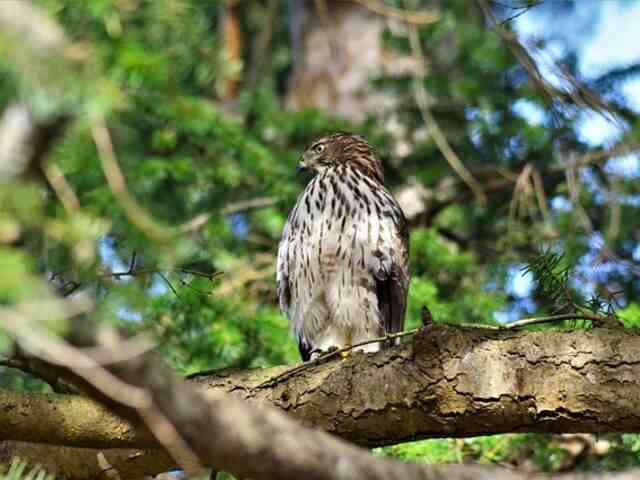
Overview of Hawks
You’re about to learn some fascinating information about these majestic birds of prey and why they’re so important to our ecosystem. Hawks are known for their sharp talons, keen eyesight, and hunting behavior.
They play a vital role in keeping the balance of nature by controlling the population of small mammals and birds.
Hawks are also known for their annual migration, which can take them thousands of miles to find their preferred habitat and food source.
Despite their impressive abilities, hawks face threats such as habitat loss, hunting, and pollution.
These factors have led to a decline in some hawk populations, making their conservation efforts crucial to maintaining a healthy ecosystem.
Now, let’s explore the population status of hawks and whether they’re endangered.
Population Status
You may be interested to know that the population of hawks has been declining in recent years. This decline can be attributed to a number of factors, including habitat loss, hunting, and pollution.
As a result, hawks are now considered to be a species of conservation concern in many parts of the world.
Decline in population
You’ve probably heard about the decline in numbers of these majestic birds. Unfortunately, the population decline of hawks is a real issue. Here are some facts about it:
- Population decline: According to recent surveys, the population of some hawk species has decreased by up to 80% in the last few decades.
- Conservation efforts: Various conservation groups and wildlife organizations are working to protect the habitats of these birds and prevent further population decline.
- Human activities: One of the main reasons for the population decline is human activities, such as habitat destruction, hunting, and pollution.
It’s important to understand the severity of the situation and take action to prevent further decline. The next section will delve deeper into the causes of decline and what can be done to address them.
Causes of decline
It’s crucial to explore the root causes of the population decline of these magnificent birds to prevent further damage to the ecosystem. Hawks are facing a number of threats, including habitat destruction, poaching, and hunting.
With urban development and deforestation, hawks are losing their natural habitats and are struggling to find suitable nesting sites.
Additionally, poaching and hunting have been a significant cause of population decline, as hawks are often targeted for their feathers, meat, and talons.
These activities have contributed to a significant reduction in hawk populations, particularly in areas where hunting and poaching are prevalent.
To ensure the survival of these magnificent birds, it’s important to address these threats and take measures to protect their habitats and reduce poaching and hunting.
Conservation efforts play a critical role in preserving the natural habitats of hawks and reducing the impact of human activity on their populations.
With continued conservation efforts, we can help preserve the population of hawks and ensure their survival for generations to come.
Now, let’s explore the conservation status of hawks to understand the current state of their populations.
Conservation status
As you step into the world of hawk conservation, you’ll find yourself surrounded by a mosaic of efforts to protect and preserve these majestic creatures. Conservation efforts have been ongoing for decades and have seen some success.
Policy changes have also played a significant role in the protection of hawks. The Endangered Species Act of 1973 has been instrumental in the conservation of many species, including some species of hawks.
Furthermore, organizations such as The Peregrine Fund and The HawkWatch International have been actively involved in the conservation of hawks.
These organizations work towards the protection of hawks and their habitats through research, education, and advocacy.
Despite these efforts, several species of hawks remain endangered. The conservation status of hawks varies depending on the species and the region. While some species are thriving, others continue to decline.
The threats to hawks are numerous and complex, making conservation efforts challenging. However, with continued research, education, and advocacy, it’s possible to protect and preserve these majestic birds for future generations.

Threats to Hawks
You may be interested to know that hawks face several threats in their daily lives. These include habitat loss and degradation, climate change, and human activities.
Deforestation, urbanization, and agriculture all contribute to the loss and degradation of hawk habitats, which can lead to population declines.
Climate change can also affect hawks by altering their food sources and migration patterns.
Finally, human activities such as hunting, trapping, and poisoning can directly harm hawks and their prey.
Habitat loss and degradation
Losing habitat due to human activity has had a major impact on where these majestic birds can call home. Hawks are particularly vulnerable to habitat loss and degradation, as they require large areas of open space to hunt and nest.
The effects of urbanization have caused a significant reduction in the amount of available habitat, as cities and towns expand and encroach on previously undisturbed areas.
This has also impacted the availability of prey, as hawks rely on open spaces to hunt their food.
Additionally, habitat degradation due to pollution and destruction of natural habitats further exacerbates the problem. As a result, many species of hawks are now classified as threatened or endangered.
It’s important to take steps to protect and preserve their habitats if we want to ensure their survival in the wild. Moving on to climate change, this also poses a significant threat to these beautiful birds of prey.
Climate change
As we discussed earlier, habitat loss and degradation are major threats to the survival of hawks. However, there’s another factor that’s becoming increasingly important: climate change.
The impact of climate change on hawks is complex and multifaceted. As temperatures rise and weather patterns become more unpredictable, hawks are forced to adapt to changing conditions.
Some species may be able to shift their ranges or alter their breeding schedules, while others may struggle to find suitable food sources or nesting sites.
Overall, the long-term effects of climate change on hawk populations are uncertain, but it’s clear that it’s an important issue that needs to be addressed.
As you consider the impact of climate change on these majestic birds, you may also start to think about the ways that human activities are exacerbating this problem.
Human activities
Human activities are wreaking havoc on the environment, causing irreparable damage that will have long-lasting consequences. One of the major impacts of human activities on hawk populations is hunting.
Many species of hawks are hunted either for sport or for their feathers, which are used in traditional ceremonies. This has led to a significant decline in their numbers over the years.
Another factor that has contributed to the decline of hawk populations is urbanization.
As more and more land is developed for human use, the natural habitats of hawks are destroyed, leaving them with no place to live. This has led to a decrease in their numbers, and in some cases, even extinction.
It is important to understand the impact of our actions on the environment and take steps to protect these magnificent creatures.
Efforts to protect hawks include creating protected areas for them to live in, banning hunting practices, and educating people about the importance of these birds in our ecosystem.
By working together, we can help ensure that hawks and other endangered species are able to thrive and continue to play a vital role in our world.
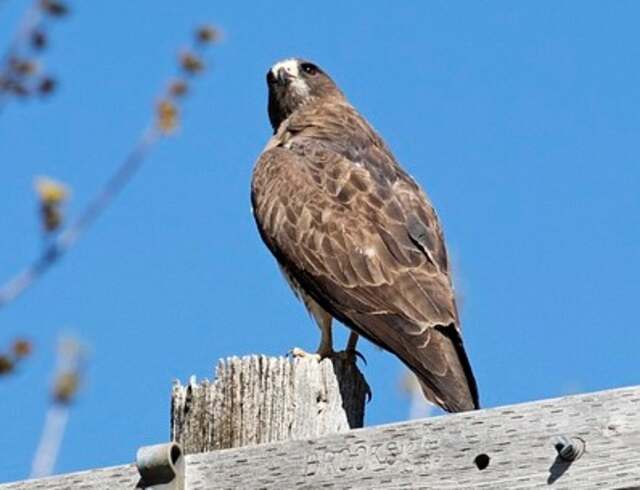
Efforts to Protect Hawks
You can help protect these magnificent birds by supporting conservation programs and spreading awareness about their importance in the ecosystem.
There are many ways you can contribute to hawk conservation, including donating to organizations that work to conserve and protect these birds, volunteering with local rehabilitation efforts, and advocating for stronger protections for hawks and their habitats.
By supporting these efforts, you can help ensure that these beautiful birds continue to thrive in the wild for generations to come.
Additionally, learning more about hawks and their role in the ecosystem can help you develop a deeper appreciation for these magnificent creatures, making it easier to spread awareness and advocate for their protection.
With your help, we can work to protect and preserve these important birds for years to come.
As we move into the next section, we’ll explore the important work being done to rehabilitate and rescue hawks in need.
Rehabilitation and Rescue
You may be interested to know about the rehabilitation and rescue efforts that are being made to protect hawks.
Hawk rehabilitation centers have been established to provide medical care and treatment to injured or sick hawks.
Rescue and release programs also exist to rescue and release hawks back into the wild after their rehabilitation.
This is an important effort to protect hawks and ensure the survival of their species.
Hawk rehabilitation centers
There’s a growing need for more hawk rehabilitation centers, as injured birds of prey often require specialized care and attention in order to fully recover and return to the wild.
Hawk care involves a variety of rehabilitation methods, including medication, surgery, physical therapy, and proper nutrition.
These centers provide a safe and nurturing environment for hawks to heal and regain their strength.
The staff and volunteers at these centers are skilled in handling injured hawks and are dedicated to helping them fly free once again.
For example, a red-tailed hawk named Rosie was recently brought to a rehabilitation center with a broken wing.
With the help of these centers, Rosie was able to recover and was eventually released back into the wild.
The success stories of these centers demonstrate the importance of their work in protecting and preserving hawk populations.
Rescue and release programs are crucial in providing injured hawks with a second chance at life in the wild.
Rescue and release programs
Now that you know about hawk rehabilitation centers, you might be wondering about the rescue and release programs that they offer.
These programs are designed to help injured or orphaned hawks recover and eventually return to their natural habitat.
Rescue programs can involve individuals or organizations, such as wildlife rehabilitation centers, that respond to calls for injured or sick hawks.
Once the hawk is brought to a rehabilitation center, the staff will assess its injuries and provide medical care as needed.
The goal of rehabilitation centers is to provide the necessary care and support for these birds so that they can recover and become strong enough to be released back into the wild.
These programs are crucial for the survival of endangered hawk species, such as the red-shouldered hawk and the ferruginous hawk.
By participating in these rescue and release programs, you can help protect these magnificent birds and ensure that they continue to thrive.
And speaking of protection and preservation, the next section will discuss the importance of rehabilitation.
Importance of rehabilitation
If you come across a hawk that’s been injured or orphaned, it’s important to know that rehabilitation centers play a vital role. They nurse these majestic creatures back to health and give them a second chance to soar through the skies.
The importance of rehabilitation cannot be overstated. It enables hawks to regain their strength and return to their natural habitat.
Benefits of rehabilitation include providing medical care, food, and shelter to injured or orphaned hawks, as well as teaching them how to hunt and fend for themselves.
Without rehabilitation centers, many hawks would not survive and their populations could decline. These programs are essential for the preservation of hawks and for maintaining a healthy ecosystem.
As you learn about the important role of rehabilitation, you’ll also discover the crucial role that hawks play in the ecosystem.
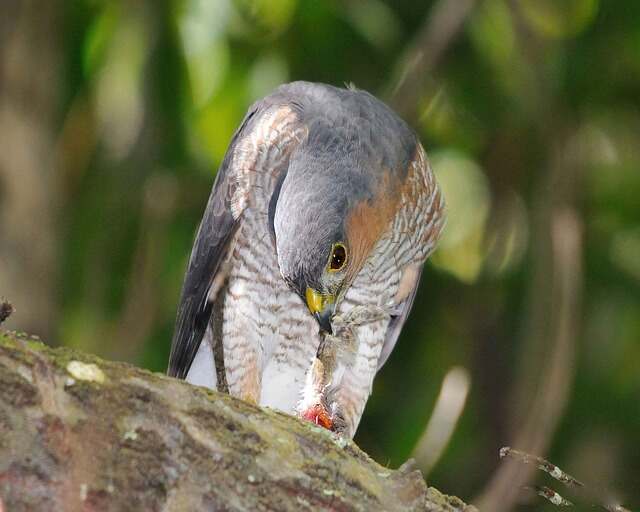
Role of Hawks in the Ecosystem
The presence of hawks within their ecosystem helps to regulate populations of prey animals, creating a natural balance that supports biodiversity and promotes a healthy environment.
Hawks play an important role in predation, as they are efficient hunters that keep rodent populations in check.
Did you know that a single hawk can consume up to 1,000 rodents in a year?
This impact on rodent populations has a domino effect on the entire ecosystem, preventing overgrazing and preserving vegetation that supports other animals.
By maintaining a balance in the food chain, hawks contribute to the health and sustainability of their habitat.
As you learn about the role of hawks in the ecosystem, you may wonder what you can do to help these remarkable birds thrive in the wild.
Ways to Help Hawks
There are several things we can do to support the well-being and conservation of these majestic birds of prey.
1) One way to help hawks is to protect their nesting areas. Hawks build their nests in trees, and deforestation and habitat loss can have a negative impact on their population.
By advocating for the protection of forests and woodlands, we can help ensure that hawks have a safe place to nest and raise their young.
2) Another way to support hawks is to protect their food sources. Hawks primarily feed on small mammals, such as mice and rabbits.
By reducing the use of pesticides and providing habitat for these small animals, we can help ensure that hawks have a steady supply of food.
3) Lastly, we can support hawk conservation efforts by donating to organizations that work to protect these birds and their habitats.
By contributing to these organizations, we can help fund research, education, and conservation efforts that are essential for the survival of these magnificent birds.
By taking these actions, we can help ensure that hawks continue to thrive in our ecosystems.
As we conclude, let’s remember that the well-being of hawks isn’t just important for their survival, but for the health of our entire ecosystem.
Frequently Asked Questions
How do hawks mate and reproduce?
When it comes to hawk breeding habits, these birds are known for their monogamous relationships. They typically mate for life, choosing one partner to raise their offspring with.
Hawks usually nest in high, secluded areas such as trees or cliffs. The female hawk will lay her eggs in the nest and both parents take turns incubating them until they hatch.
Once the chicks have hatched, the parents work together to feed and care for them until they are old enough to leave the nest. Overall, hawk nesting behavior is a fascinating process to observe, and it’s clear that these birds are committed to their family’s well-being.
For those who have a subconscious desire for freedom, the dedication and loyalty of these birds to their partners and offspring may be inspiring.
What is the average lifespan of a hawk?
If you’re curious about how long a hawk typically lives, you might be interested to know that their average lifespan is around 10 to 20 years. Of course, this can vary depending on the species, with some living longer than others.
Hawks are known for their sharp talons and keen eyesight, which they use to hunt small prey such as rodents, birds, and insects.
To maintain their hunting skills and overall health, they require a diet that’s high in protein and other nutrients.
Hawks are also known for their strong wings, which allow them to soar through the skies with ease.
Whether you’re a bird enthusiast or simply curious about these fascinating creatures, learning about a hawk’s average lifespan and diet requirements can help you better understand and appreciate their unique qualities.
How do hawks communicate with each other?
Did you know that hawks are highly social animals that communicate with each other through vocalizations and visual displays?
One interesting statistic is that some species of hawks have over 20 different calls that they use to communicate with other hawks in their territory.
Hawk vocalizations range from high-pitched screams to low-pitched whistles, and each call has a specific meaning.
Hawks also use visual displays, such as flying in circles or flapping their wings, to communicate with other hawks. Their hunting behavior and prey selection are also influenced by their communication with each other.
Despite their social nature, hawks are still fierce predators that rely on their keen senses and hunting skills to survive in the wild.
What is the difference between a hawk and a falcon?
If you’re fascinated by birds of prey, you might be wondering about the differences between hawks and falcons.
One key difference is in their hunting techniques – hawks typically hunt by perching and waiting for prey to come within range, while falcons prefer to fly high and dive down on their prey.
Another difference is in their physical characteristics – hawks tend to have broader wings and a stockier build, while falcons are more streamlined and have longer wings for faster flight.
While both hawks and falcons are powerful hunters, each has its own unique strengths and abilities.
Whether you’re interested in the graceful falcon or the mighty hawk, it’s clear that both of these birds are impressive creatures that embody the freedom and power of the natural world.
Can hawks be trained for falconry or hunting purposes?
Interested in training a hawk for falconry or hunting purposes? It’s not a simple process, but it is possible. Training techniques vary, but often involve a process called ‘manning’ where the hawk is gradually acclimated to human presence and handling.
Additionally, there are legal regulations in place to protect these birds of prey. It’s important to research and follow the appropriate permits and guidelines before embarking on any training.
With patience, dedication, and a deep respect for these magnificent birds, it’s possible to successfully train a hawk for falconry or hunting purposes.
Conclusion
Congratulations on reaching the end of this article about the status of hawks! By now, you should be well-informed about the challenges that these majestic birds face, including habitat loss, hunting, and poisoning.
However, there is still hope for the future of hawks, thanks to the efforts of conservationists, rehabilitation centers, and concerned citizens like you.
Perhaps you’ve been inspired by the beauty and resilience of hawks, and you want to do your part to help them thrive.
There are many ways to get involved, from volunteering at a wildlife rescue center to supporting legislation that protects endangered species.
By taking action, you can help ensure that future generations will have the opportunity to witness the awe-inspiring sight of a hawk soaring through the sky. Remember, every little bit counts!

